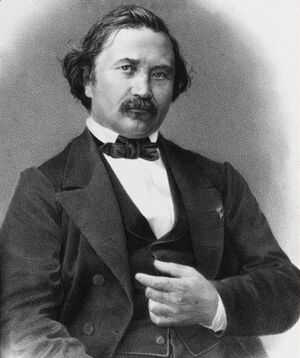Joseph Bertrand (nonfiction): Difference between revisions
No edit summary |
No edit summary |
||
| Line 31: | Line 31: | ||
* [[Carl Friedrich Gauss (nonfiction)]] | * [[Carl Friedrich Gauss (nonfiction)]] | ||
* [[Mathematics (nonfiction)]] | * [[Mathematics (nonfiction)]] | ||
* [[Number theory (nonfiction)]] | |||
External links: | External links: | ||
| Line 37: | Line 38: | ||
[[Category:Nonfiction (nonfiction)]] | [[Category:Nonfiction (nonfiction)]] | ||
[[Category:Differential geometers (nonfiction)]] | |||
[[Category:Mathematicians (nonfiction)]] | [[Category:Mathematicians (nonfiction)]] | ||
[[Category:Number theorists (nonfiction)]] | |||
[[Category:People (nonfiction)]] | [[Category:People (nonfiction)]] | ||
[[Category:Probability theorists (nonfiction)]] | |||
Revision as of 20:56, 29 December 2018
Joseph Louis François Bertrand (11 March 1822 – 5 April 1900, born and died in Paris) was a French mathematician who worked in the fields of number theory, differential geometry, probability theory, economics and thermodynamics.
He was the son of physician Alexandre Jacques François Bertrand and the brother of archaeologist Alexandre Bertrand.
At eleven years old he attended the course of the École Polytechnique as an auditor (open courses). From age eleven to seventeen, he obtained two bachelor's degrees, a license and a PhD with a thesis on the mathematical theory of electricity and is admitted first to the 1839 entrance examination of the École Polytechnique.
He conjectured, in 1845, that there is at least one prime between n and 2n − 2 for every n > 3. Chebyshev proved this conjecture, now called Bertrand's postulate, in 1850. He was also famous for a paradox in the field of probability, now known as Bertrand's Paradox. There is another paradox in game theory that is named after him, called the Bertrand Paradox.
Bertrand translated into French Carl Friedrich Gauss's work on the theory of errors and the method of least squares.
In the field of economics he reviewed the work on oligopoly theory, specifically the Cournot Competition Model (1838) of French mathematician Antoine Augustin Cournot. His Bertrand Competition Model (1883) argued that Cournot had reached a very misleading conclusion, and he reworked it using prices rather than quantities as the strategic variables, thus showing that the equilibrium price was simply the competitive price.
His book Thermodynamique points out in Chapter XII, that thermodynamic entropy and temperature are only defined for reversible processes. He was one of the first people to point this out.
In the News
Fiction cross-reference
Nonfiction cross-reference
- Antoine Augustin Cournot (nonfiction)
- Carl Friedrich Gauss (nonfiction)
- Mathematics (nonfiction)
- Number theory (nonfiction)
External links:
- Joseph Bertrand @ Wikipedia

